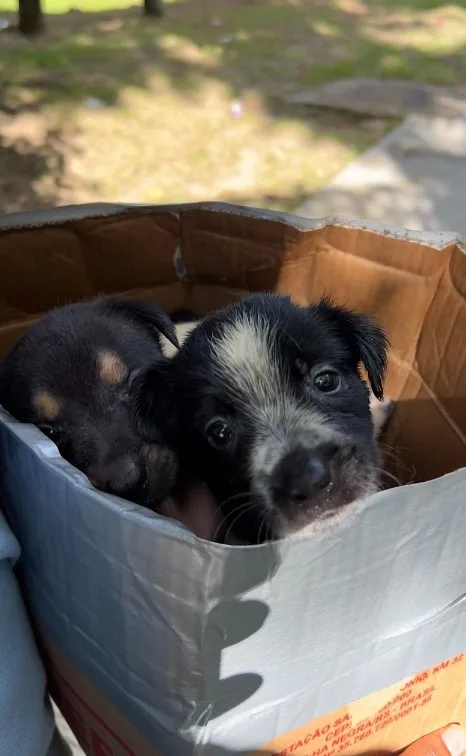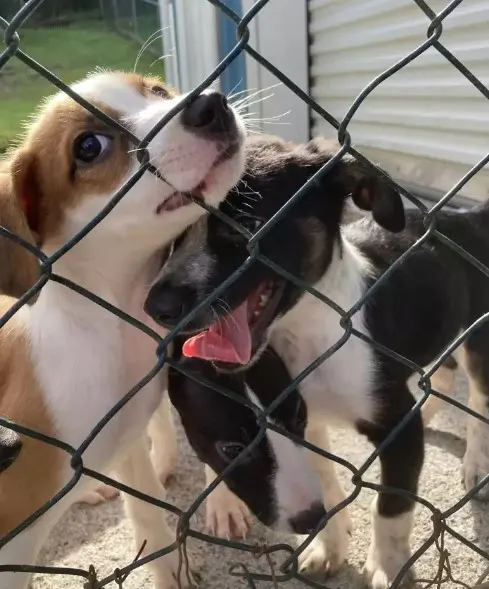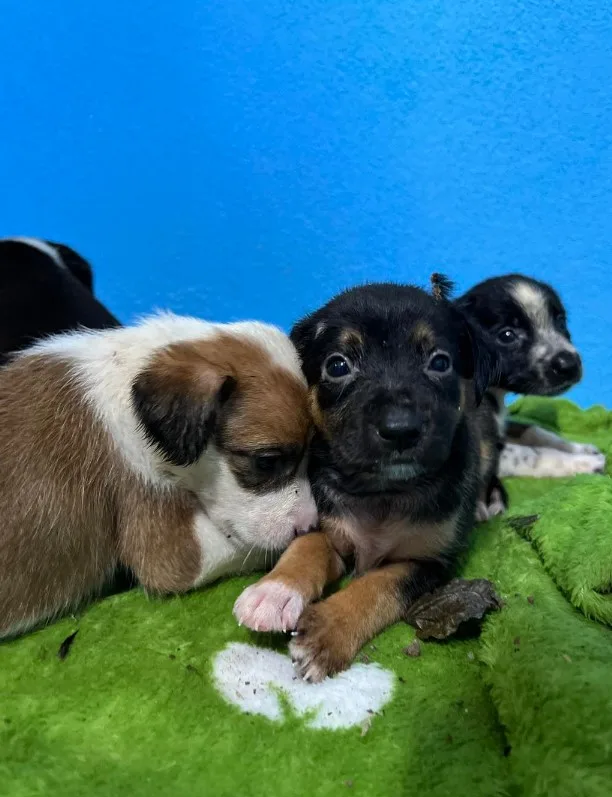HelpAWS is an animal rescue organization based in Saint Lucia, which organizes a clinic every year dedicated to spaying and neutering.
This event plays a big role in managing the dog population on the island.
Even though it is hard work, the veterinarians and staff feel incredible knowing that they spent their time helping dogs in need.
They were once again reminded of this after they extended their working hours to help a pack of puppies who really needed it!
Mystery Box

Day three of the Saint Lucia clinic was just as busy as any other. When the work hours finally came to an end, the whole staff was happy to be heading home.
However, something stopped them in their tracks.
“[We] noticed the cardboard box sitting on the ground next to the trash can. We stopped to investigate, knowing what we would find but willing it not to be true,” said Charlene Penney Troubetzkoy, the founder and CEO of HelpAWS.
Snuggling inside of the tiny cardboard box were five of the most adorable little puppies.

Even though Charlene, throughout her work, has seen many dogs in difficult situations, one simply can’t get used to it.
No matter how many times it happens, it still makes my heart sink to look inside and see tired, scared little eyes looking back at me.
To The Shelter
The rescue staff, not wanting to waste time, rushed the puppies back to the shelter where every one of them got a nice and thorough checkup.
Even though they were being well taken care of, the puppies needed some time to get used to their new environment.

They were scared at first, which is common. It didn’t take them long to realize they were finally somewhere safe, though, where they would be fed and loved.
After their medical examination, the little pack was more than welcome to enjoy their time at the shelter.

Even though the siblings love to spend their time together, they were ready to find their forever home.
Leaving the shelter one by one, each reminded the staff of how rewarding their job really is.
Thank you to HelpAWS and anyone who is a part of this line of work for helping this little dog bunch in need, even when they were tired themselves.
If you’ve ever been greeted by your furry friend with a not-so-pleasant odor emanating from their mouth, you’re not alone. Dog breath that could peel paint is a common concern among pet owners. As an experienced dog trainer, you understand that a dog’s bad breath can be more than just a nuisance – it could be a sign of underlying health issues.
You know that a dog’s halitosis can stem from various factors, ranging from poor dental hygiene to diet and potential health problems. As you strive to ensure the well-being of your canine companion, uncovering the reasons behind their foul breath becomes crucial. Stay tuned to discover the possible causes and practical solutions to tackle this stinky situation.
Understanding Why Your Dog’s Breath Stinks
Common Causes of Bad Breath in Dogs
- Poor Dental Hygiene: Just like humans, dogs need regular dental care. If you neglect brushing their teeth, plaque and tartar build-up can lead to bad breath.
- Diet: Your dog’s diet plays a crucial role in their breath. Certain foods can cause bad breath, while others can help freshen it up.
- Health Problems: Underlying health issues such as gum disease, oral infections, or digestive issues can result in foul-smelling breath.
- Dental Disease: One of the most common reasons for bad breath in dogs is dental disease. This includes gingivitis, periodontal disease, and oral infections.
- Digestive Disorders: Issues in the gastrointestinal tract can also manifest as bad breath in dogs. Conditions like gastritis, reflux, or bowel obstructions may contribute to foul-smelling breath.
- Systemic Diseases: Some systemic diseases like diabetes, kidney disease, or liver problems can cause changes in your dog’s breath odor, indicating an underlying health issue that needs attention.
Oral Hygiene and Its Impact on Breath
The Importance of Regular Teeth Brushing
Maintaining your dog’s oral hygiene is crucial in preventing bad breath. Just like humans, dogs need regular teeth brushing to remove plaque and tartar buildup, which are major causes of foul odor. Brush your dog’s teeth at least a few times a week using a toothbrush and toothpaste specifically designed for dogs. This simple routine can significantly improve your furry friend’s breath and overall dental health.
Dental Treats and Chews as Solutions
In addition to brushing, consider incorporating dental treats and chews into your dog’s daily routine. These treats are designed to reduce plaque and freshen breath while giving your pup something tasty to enjoy. Look for dental treats that carry the Veterinary Oral Health Council (VOHC) seal, ensuring they meet specific standards for dental health benefits. Regularly offering your dog dental treats can be a fun and effective way to combat bad breath and support their oral hygiene.
Diet’s Role in Your Dog’s Oral Health
When it comes to your dog’s breath, their diet plays a crucial role in maintaining oral health. The food they eat can impact the freshness of their breath and overall dental well-being. Here’s how different foods can affect your furry friend:
Foods That Can Improve Breath
- Carrots: Crunchy fruits and vegetables like carrots can help clean your dog’s teeth and freshen their breath. The texture aids in removing plaque and tartar buildup, promoting better breath.
- Apples: Fresh slices of apples can also act as natural toothbrushes for your dog, reducing bacteria in their mouth and contributing to better breath.
- Parsley: This herb isn’t just for garnish; it contains chlorophyll, which is known to neutralize odors and freshen breath. Adding a sprinkle of parsley to your dog’s meal can help combat bad breath.
- Sugary Treats: Just like in humans, sugary snacks can lead to bad breath in dogs. Bacteria in the mouth feed on sugar, releasing foul-smelling gases that cause bad breath.
- Dairy Products: While dairy can be a good source of nutrients, it can also contribute to bad breath in some dogs. Lactose intolerance or allergies to dairy can result in smelly breath.
By being mindful of the foods you include in your dog’s diet, you can help improve their breath and oral health. Incorporating breath-freshening foods and avoiding items that worsen breath odor can make a noticeable difference in keeping your dog’s breath fresh and their teeth healthy.
Professional Care for Your Dog’s Oral Health
When to Visit the Vet for Bad Breath
If your dog’s bad breath persists despite improved dental care and dietary changes, it’s time to schedule a visit to the vet. Persistent bad breath could indicate underlying dental issues such as gum disease, infections, or other health concerns. Your vet can conduct a thorough examination to pinpoint the cause of the bad breath and recommend appropriate treatment.
Professional Cleaning and Its Benefits
Professional dental cleanings for your dog are essential for maintaining optimal oral health. Veterinarians have the expertise and tools to perform a deep cleaning, including scaling and polishing your dog’s teeth to remove stubborn plaque and tartar. These cleanings help prevent gum disease, cavities, and other dental issues that can lead to bad breath and discomfort for your furry friend. Regular professional cleanings can significantly improve your dog’s overall oral health and keep their breath fresh.
Preventative Measures to Keep Your Dog’s Breath Fresh
Daily Oral Care Practices
To maintain your dog’s fresh breath, make sure to brush their teeth daily with a dog-friendly toothbrush and toothpaste. These products are specifically formulated for your furry friend’s oral health. Additionally, giving them dental chews and toys designed to promote dental hygiene can help reduce plaque and tartar buildup, keeping their breath smelling better.
Regular Check-Ups and Cleanings
Regular visits to the vet for check-ups and professional cleanings are crucial in ensuring your dog’s oral health. Your vet can spot any potential issues early on, preventing bad breath caused by dental problems. Professional cleanings are essential to remove any stubborn tartar that regular brushing may miss, keeping your dog’s mouth fresh and healthy.
Conclusion
So, there you have it – the lowdown on why your furry friend’s breath might be a bit on the stinky side. Remember, keeping up with their dental care, watching their diet, and staying on top of any health issues are key to combating bad breath. By incorporating daily oral care practices and scheduling regular vet visits, you can ensure your dog’s breath stays fresh and their oral health remains in top shape. So, don’t let bad breath get in the way of those cuddle sessions – take care of your pup’s teeth, and you’ll both be happier for it!
Frequently Asked Questions
Why does my dog have bad breath?
Bad breath in dogs can be caused by poor dental hygiene, diet, or underlying health issues. It’s crucial to brush your dog’s teeth regularly, provide dental treats approved by VOHC, and visit the vet for check-ups.
How can I prevent my dog’s bad breath?
Prevent bad breath by incorporating daily oral care practices, such as brushing with dog-friendly toothpaste, offering dental chews, and scheduling regular vet visits for professional cleanings. Maintaining good oral health is key to fresh breath in dogs.
[no_toc]

Hey there, I’m Janet Brooks, a dog-loving student from California. I’m all about helping pups in need, especially those without homes. Me and my awesome friends work together to give shelter and love to stray dogs. Oh, and I also write blogs about dogs to share helpful info.